Section 3.1 Defining the Derivative
Learning Objectives.
Recognize the meaning of the tangent to a curve at a point.
Calculate the slope of a tangent line.
Identify the derivative as the limit of a difference quotient.
Calculate the derivative of a given function at a point.
Describe the velocity as a rate of change.
Explain the difference between average velocity and instantaneous velocity.
Estimate the derivative from a table of values.
Now that we have both a conceptual understanding of a limit and the practical ability to compute limits, we have established the foundation for our study of calculus, the branch of mathematics in which we compute derivatives and integrals. Most mathematicians and historians agree that calculus was developed independently by the Englishman Isaac Newton \(\text{ (1643–1727) }\) and the German Gottfried Leibniz \(\text{ (1646–1716), }\) whose images appear in Figure 3.2. When we credit Newton and Leibniz with developing calculus, we are really referring to the fact that Newton and Leibniz were the first to understand the relationship between the derivative and the integral. Both mathematicians benefited from the work of predecessors, such as Barrow, Fermat, and Cavalieri. The initial relationship between the two mathematicians appears to have been amicable; however, in later years a bitter controversy erupted over whose work took precedence. Although it seems likely that Newton did, indeed, arrive at the ideas behind calculus first, we are indebted to Leibniz for the notation that we commonly use today.

Subsection 3.1.1 Tangent Lines
We begin our study of calculus by revisiting the notion of secant lines and tangent lines. Recall that we used the slope of a secant line to a function at a point \((a,f(a))\) to estimate the rate of change, or the rate at which one variable changes in relation to another variable. We can obtain the slope of the secant by choosing a value of \(x\) near \(a\) and drawing a line through the points \((a,f(a))\) and \((x,f(x)),\) as shown in Figure 3.5. The slope of this line is given by an equation in the form of a difference quotient:
We can also calculate the slope of a secant line to a function at a value \(a\) by using this equation and replacing \(x\) with \(a+h,\) where \(h\) is a value close to 0. We can then calculate the slope of the line through the points \((a,f(a))\) and \((a+h,f(a+h)).\) In this case, we find the secant line has a slope given by the following difference quotient with increment \(h\text{ : }\)
Definition 3.3.
Let \(f\) be a function defined on an interval \(I\) containing \(a.\) If \(x\neq a\) is in \(I,\) then
is a difference quotient.
Also, if \(h\neq 0\) is chosen so that \(a+h\) is in \(I,\) then
is a difference quotient with increment \(h.\)
Note 3.4.
View the development of the derivative 1 with this applet.
These two expressions for calculating the slope of a secant line are illustrated in Figure 3.5. We will see that each of these two methods for finding the slope of a secant line is of value. Depending on the setting, we can choose one or the other. The primary consideration in our choice usually depends on ease of calculation.
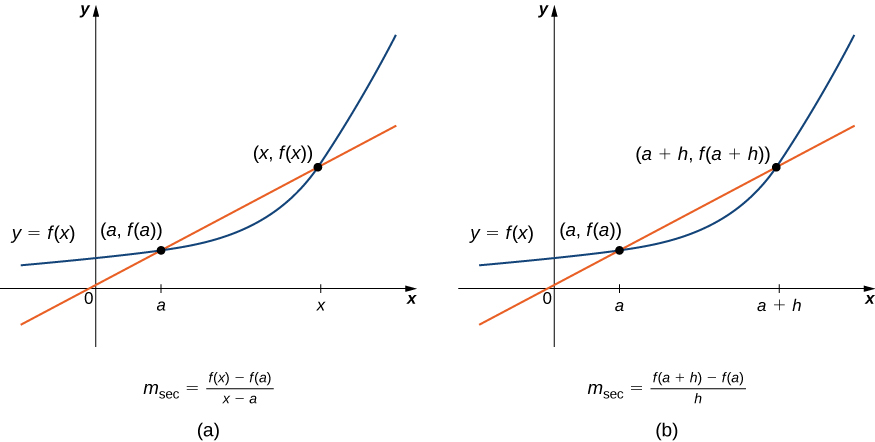
In Figure 3.6(a) we see that, as the values of \(x\) approach \(a,\) the slopes of the secant lines provide better estimates of the rate of change of the function at \(a.\) Furthermore, the secant lines themselves approach the tangent line to the function at \(a,\) which represents the limit of the secant lines. Similarly, Figure 3.6(b) shows that as the values of \(h\) get closer to \(0,\) the secant lines also approach the tangent line. The slope of the tangent line at \(a\) is the rate of change of the function at \(a,\) as shown in Figure 3.6(c).
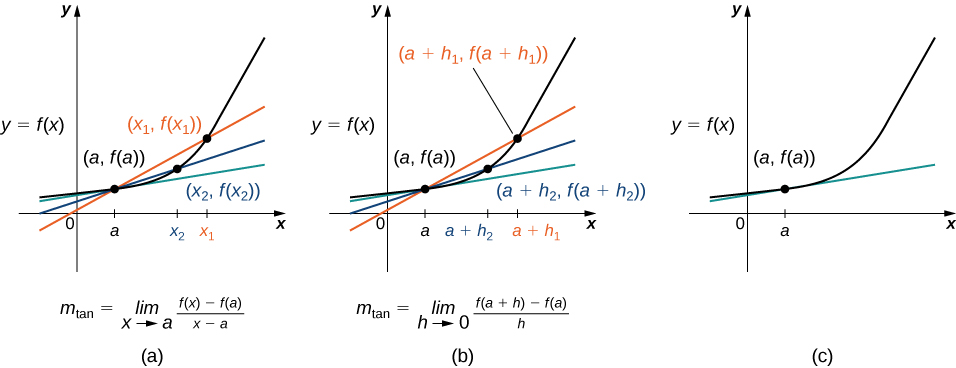
Note 3.7.
You can use this site 2 to explore graphs to see if they have a tangent line at a point.
In Figure 3.8 we show the graph of \(f(x)=\sqrt{x}\) and its tangent line at \((1,1)\) in a series of tighter intervals about \(x=1.\) As the intervals become narrower, the graph of the function and its tangent line appear to coincide, making the values on the tangent line a good approximation to the values of the function for choices of \(x\) close to \(1.\) In fact, the graph of \(f(x)\) itself appears to be locally linear in the immediate vicinity of \(x=1.\)
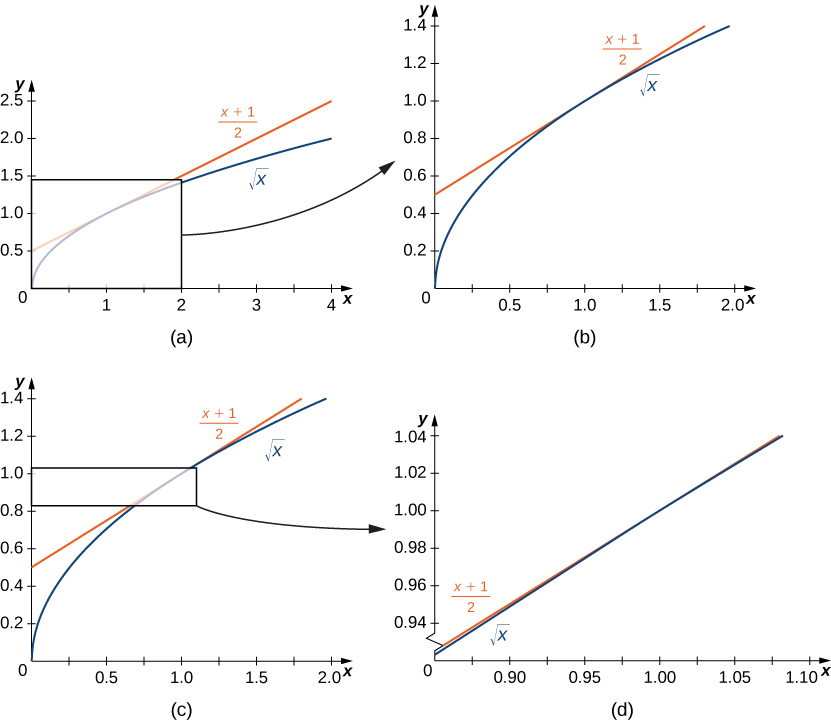
Formally we may define the tangent line to the graph of a function as follows.
Definition 3.9.
Let \(f(x)\) be a function defined in an open interval containing \(a.\) The tangent line to \(f(x)\) at \(a\) is the line passing through the point \((a,f(a))\) having slope
provided this limit exists.
Equivalently, we may define the tangent line to \(f(x)\) at \(a\) to be the line passing through the point \((a,f(a))\) having slope
provided this limit exists.
Just as we have used two different expressions to define the slope of a secant line, we use two different forms to define the slope of the tangent line. In this text we use both forms of the definition. As before, the choice of definition will depend on the setting. Now that we have formally defined a tangent line to a function at a point, we can use this definition to find equations of tangent lines.
Example 3.10.
Find the equation of the line tangent to the graph of \(f(x)=x^2\) at \(x=3.\)
First find the slope of the tangent line. In this example, use (3.1.1).
Next, find a point on the tangent line. Since the line is tangent to the graph of \(f(x)\) at \(x=3,\) it passes through the point \((3,f(3)).\) We have \(f(3)=9,\) so the tangent line passes through the point \((3,9).\)
Using the point-slope equation of the line with the slope \(m=6\) and the point \((3,9),\) we obtain the line \(y-9=6(x-3).\) Simplifying, we have \(y=6x-9.\) The graph of \(f(x)=x^2\) and its tangent line at \(3\) are shown in Figure 3.11.
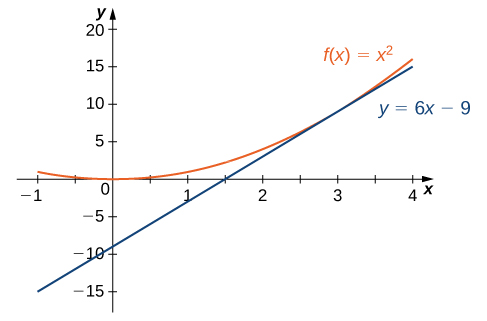
Example 3.12. The Slope of a Tangent Line Revisited.
Use (3.1.2) to find the slope of the line tangent to the graph of \(f(x)=x^2\) at \(x=3.\)
The steps are very similar to Example 3.10. See (3.1.2) for the definition.
We obtained the same value for the slope of the tangent line by using the other definition, demonstrating that the formulas can be interchanged.
Example 3.13. Finding the Equation of a Tangent Line.
Find the equation of the line tangent to the graph of \(f(x)=1\text{ / }x\) at \(x=2.\)
We can use (3.1.1), but as we have seen, the results are the same if we use (3.1.2).
We now know that the slope of the tangent line is \(-\frac{1}{4}.\) To find the equation of the tangent line, we also need a point on the line. We know that \(f(2)=\frac{1}{2}.\) Since the tangent line passes through the point \((2,\frac{1}{2})\) we can use the point-slope equation of a line to find the equation of the tangent line. Thus the tangent line has the equation \(y=-\frac{1}{4}x+1.\) The graphs of \(f(x)=\frac{1}{x}\) and \(y=-\frac{1}{4}x+1\) are shown in Figure 3.14.
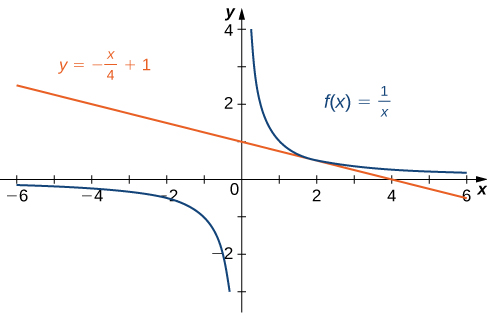
Checkpoint 3.15.
Find the slope of the line tangent to the graph of \(f(x)=\sqrt{x}\) at \(x=4.\)
Subsection 3.1.2 The Derivative of a Function at a Point
The type of limit we compute in order to find the slope of the line tangent to a function at a point occurs in many applications across many disciplines. These applications include velocity and acceleration in physics, marginal profit functions in business, and growth rates in biology. This limit occurs so frequently that we give this value a special name: the derivative. The process of finding a derivative is called differentiation.
Definition 3.16.
Let \(f(x)\) be a function defined in an open interval containing \(a.\) The derivative of the function \(f(x)\) at \(a,\) denoted by \(f'(a),\) is defined by
provided this limit exists.
Alternatively, we may also define the derivative of \(f(x)\) at \(a\) as
Example 3.17. Estimating a Derivative.
For \(f(x)=x^2,\) use a table to estimate \(f'(3)\) using (3.1.3).
Create a table using values of \(x\) just below \(3\) and just above \(3.\)
| \(x\) | \(\frac{x^2-9}{x-3}\) |
|---|---|
| \(2.9\) | \(5.9\) |
| \(2.99\) | \(5.99\) |
| \(2.999\) | \(5.999\) |
| \(3.001\) | \(6.001\) |
| \(3.01\) | \(6.01\) |
| \(3.1\) | \(6.1\) |
After examining the table, we see that a good estimate is \(f'(3)=6.\)
Checkpoint 3.19.
For \(f(x)=x^2,\) use a table to estimate \(f'(3)\) using (3.1.4).
Example 3.20. Finding a Derivative.
For \(f(x)=3x^2-4x+1,\) find \(f'(2)\) by using (3.1.3).
Substitute the given function and value directly into the equation.
Example 3.21. Revisiting the Derivative.
For \(f(x)=3x^2-4x+1,\) find \(f'(2)\) by using (3.1.4).
Using this equation, we can substitute two values of the function into the equation, and we should get the same value as in Example 3.20.
Checkpoint 3.22.
For \(f(x)=x^2+3x+2,\) find \(f'(1).\)
Use either (3.1.3), (3.1.4), or try both. Use either Example 3.13 or Example 3.17 as a guide.
\(f'(1)=5\)
Subsection 3.1.3 Velocities and Rates of Change
Now that we can evaluate a derivative, we can use it in velocity applications. Recall that if \(s(t)\) is the position of an object moving along a coordinate axis, the average velocity of the object over a time interval \([a,t]\) if \(t\gt a\) or \([t,a]\) if \(t\lt a\) is given by the difference quotient
As the values of \(t\) approach \(a,\) the values of \(v_\text{ ave }\) approach the value we call the instantaneous velocity at \(a.\) That is, instantaneous velocity at \(a,\) denoted \(v(a),\) is given by
To better understand the relationship between average velocity and instantaneous velocity, see Figure 3.23. In this figure, the slope of the tangent line (shown in red) is the instantaneous velocity of the object at time \(t=a\) whose position at time \(t\) is given by the function \(s(t).\) The slope of the secant line (shown in green) is the average velocity of the object over the time interval \([a,t].\)
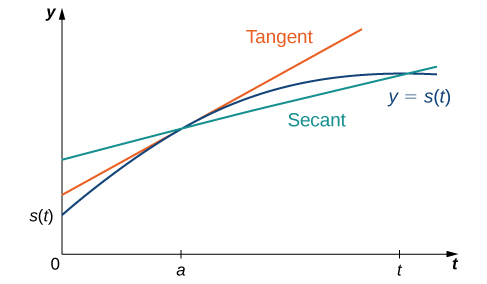
We can use (3.1.3) to calculate the instantaneous velocity, or we can estimate the velocity of a moving object by using a table of values. We can then confirm the estimate by using (3.1.5).
Example 3.24. Estimating Marginal Cost.
The cost function for coffee is given by \(C(x)=\frac{18}{x}\) where \(x\) is the number of thousand items made. Use a table to estimate the marginal cost of producing 1000 items and interpret.
Using (3.1.3), we can estimate the marginal cost at \(x=1000\) by computing a table of the slopes of the secant line using values of \(x\) approaching \(1000\text{.}\) This is shown in Table 3.25.
| \(x\) | \(\frac{C(x)-C(1)}{x-1}\) |
|---|---|
| \(0.9\) | \(-20\) |
| \(0.99\) | \(-18.18181818\) |
| \(0.999\) | \(-18.01801802\) |
| \(1.001\) | \(-17.98201798\) |
| \(1.01\) | \(-17.82178218\) |
| \(1.1\) | \(-16.36363636\) |
From the table we see that the slope of the secant line over the interval \([0.9,1]\) is \(-20,\) the slope of the secant line over the interval \([0.99,1]\) is \(-18.18181818,\) and so forth. Using this table of values, it appears that a good estimate is \(C'(1)=-18.\)
When \(1000\) items are produced, the cost is decreasing at a rate of \(\$18\) per thousand items made. So if we produce \(1000\) more items, we can expect costs to drop by \(\$18\text{.}\)
Checkpoint 3.26.
A rock is dropped from a height of \(64\) feet. Its height above ground at time \(t\) seconds later is given by \(s(t)=-16t^2+64,0 \leq t \leq 2.\) Find its instantaneous velocity \(1\) second after it is dropped, using (3.1.3).
As we have seen throughout this section, the slope of a tangent line to a function and instantaneous velocity are related concepts. Each is calculated by computing a derivative and each measures the instantaneous rate of change of a function, or the rate of change of a function at any point along the function.
Definition 3.27.
The instantaneous rate of change of a function \(f(x)\) at a value \(a\) is its derivative \(f'(a).\)
Example 3.28. Chapter Opener: Estimating Rate of Change of Velocity.

Reaching a top speed of \(270.49\) mph, the Hennessey Venom GT is one of the fastest cars in the world. In tests it went from \(0\) to \(60\) mph in \(3.05\) seconds, from \(0 \text{ to } 100\) mph in \(5.88\) seconds, from \(0 \text{ to } 200\) mph in \(14.51\) seconds, and from \(0 \text{ to } 229.9\) mph in \(19.96\) seconds. Use this data to draw a conclusion about the rate of change of velocity (that is, its acceleration) as it approaches \(229.9\) mph. Does the rate at which the car is accelerating appear to be increasing, decreasing, or constant?
First observe that \(60\) mph = \(88\) ft/s, \(100\) mph \(\approx146.67\) ft/s, \(200\) mph \(\approx293.33\) ft/s, and \(229.9\) mph \(\approx337.19\) ft/s. We can summarize the information in a table.
| \(t\) | \(v(t)\) |
|---|---|
| \(0\) | \(0\) |
| \(3.05\) | \(88\) |
| \(5.88\) | \(147.67\) |
| \(14.51\) | \(293.33\) |
| \(19.96\) | \(337.19\) |
Now compute the average acceleration of the car in feet per second on intervals of the form \([t,19.96]\) as \(t\) approaches \(19.96,\) as shown in the following table.
| \(t\) | \(\frac{v(t)-v(19.96)}{t-19.96}=\frac{v(t)-337.19}{t-19.96}\) |
|---|---|
| \(0.0\) | \(16.89\) |
| \(3.05\) | \(14.74\) |
| \(5.88\) | \(13.46\) |
| \(14.51\) | \(8.05\) |
The rate at which the car is accelerating is decreasing as its velocity approaches \(229.9\) mph \((337.19\) ft/s).
Example 3.32. Rate of Change of Temperature.
A homeowner sets the thermostat so that the temperature in the house begins to drop from \(70\text{ ° }\text{ F }\) at \(9\) p.m., reaches a low of \(60\text{ ° }\) during the night, and rises back to \(70\text{ ° }\) by \(7\) a.m. the next morning. Suppose that the temperature in the house is given by \(T(t)=0.4t^2-4t+70\) for \(0 \leq t \leq 10,\) where \(t\) is the number of hours past \(9\) p.m. Find the instantaneous rate of change of the temperature at midnight.
Since midnight is \(3\) hours past \(9\) p.m., we want to compute \(T'(3).\) Refer to (3.1.3).
The instantaneous rate of change of the temperature at midnight is \(-1.6\text{ ° }\text{ F }\) per hour.
Example 3.33. Rate of Change of Profit.
A toy company can sell \(x\) electronic gaming systems at a price of \(p=-0.01x+400\) dollars per gaming system. The cost of manufacturing \(x\) systems is given by \(C(x)=100x+10,000\) dollars. Find the rate of change of profit when \(10,000\) games are produced. Should the toy company increase or decrease production?
The profit \(P(x)\) earned by producing \(x\) gaming systems is \(R(x)-C(x),\) where \(R(x)\) is the revenue obtained from the sale of \(x\) games. Since the company can sell \(x\) games at \(p=-0.01x+400\) per game,
Consequently,
Therefore, evaluating the rate of change of profit gives
Since the rate of change of profit \(P'(10,000)\gt 0\) and \(P(10,000)\gt 0,\) the company should increase production.
Checkpoint 3.34.
A coffee shop determines that the daily profit on scones obtained by charging \(s\) dollars per scone is \(P(s)=-20s^2+150s-10.\) The coffee shop currently charges \(\$3.25\) per scone. Find \(P'(3.25),\) the rate of change of profit when the price is \(\$3.25\) and decide whether or not the coffee shop should consider raising or lowering its prices on scones.
Subsection 3.1.4 Key Concepts
The slope of the tangent line to a curve measures the instantaneous rate of change of a curve. We can calculate it by finding the limit of the difference quotient or the difference quotient with increment \(h.\)
The derivative of a function \(f(x)\) at a value \(a\) is found using either of the definitions for the slope of the tangent line.
Velocity is the rate of change of position. As such, the velocity \(v(t)\) at time \(t\) is the derivative of the position \(s(t)\) at time \(t.\) Average velocity is given by
\begin{equation*} v_\text{ ave }=\frac{s(t)-s(a)}{t-a}. \end{equation*}Instantaneous velocity is given by\begin{equation*} v(a)=s'(a)=\lim_{t\to a}\frac{s(t)-s(a)}{t-a}. \end{equation*}We may estimate a derivative by using a table of values.
Subsection 3.1.5 Key Equations
Difference quotient \(Q=\frac{f(x)-f(a)}{x-a}\)
Difference quotient with increment \(h\)
\begin{equation*} Q=\frac{f(a+h)-f(a)}{a+h-a}=\frac{f(a+h)-f(a)}{h} \end{equation*}Slope of tangent line
\begin{align*} m_{\text{ tan }}\amp=\lim_{x\to a}\frac{f(x)-f(a)}{x-a}\\ m_{\text{ tan }}\amp=\lim_{h\to 0}\frac{f(a+h)-f(a)}{h} \end{align*}Derivative of \(f(x)\) at \(a\)
\begin{align*} f'(a)\amp=\lim_{x\to a}\frac{f(x)-f(a)}{x-a}\\ f'(a)\amp=\lim_{h\to 0}\frac{f(a+h)-f(a)}{h} \end{align*}Average velocity \(v_{\text{ ave }}=\frac{s(t)-s(a)}{t-a}\)
Instantaneous velocity \(\displaystyle{v(a)=s'(a)=\lim_{t\to a}\frac{s(t)-s(a)}{t-a}}\)
This book is a custom edition based on OpenStax Calculus Volume 1. You can download the original for free at https://openstax.org/details/books/calculus-volume-1.
http://www.openstax.org/l/20_calcappletshttp://www.openstax.org/l/20_diffmicros